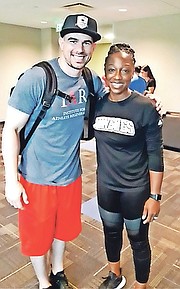UB Athletics head athletic trainer Sasha Johnson was recently certified in the sports medicine process of dry needling at the Institute of Athlete Regeneration in Houston, Texas, as a part of the department’s ongoing programme of excellence.
Dry needling is a technique used by a physical therapist and sports medicine practitioners to assist in treating pain and mobility issues among athletes.
This process is considered minimally invasive and used mostly for muscle pain and flexibility issues which are perhaps most of the problems associated with high-level athletes.
The process also helps in the treatment of some bone issues.
“One of the biggest takeaways from this is that we at UB Athletics will be more equipped to serve the student-athletes here,” Johnson said.
“This tool will prove beneficial in the treatment of our athletes - allowing them quicker recovery and enhanced performance.”
Johnson said the course paid special attention to the hamstring muscle group - the group of muscles on the back of the thigh mostly used to generate power in running and jumping.
“I valued the hamstring treatment the most because it is such a common ailment seen in the athletic training room at UB,” she added.
The course was also very pragmatic and that was valuable for Johnson as well.
“This particular course took a very hands-on approach to teach the technique of dry needling,” Johnson said.
“Of course there was the theory portion of the course but 80 per cent of the course was practical and that practical aspect gave me the confidence and proficiency needed to execute dry needling effectively.”
She also got a chance to interact with some of the top athletic trainers around the United States.
“I was able to network and meet some great sports medicine practitioners - sharing different rehab and treatment protocols as an adjunct to dry needling,” she said.
Dry needling is called “dry” because no chemical solution is involved with the insertion of the needle into the tissue.
This makes the process distinctly different from “wet” needling, which does involve an injection of a solution via a needle into connective tissue.





Comments
Use the comment form below to begin a discussion about this content.
Sign in to comment
Or login with:
OpenID